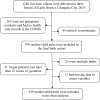The mutual effect of pre-pregnancy body mass index, waist circumference and gestational weight gain on obesity-related adverse pregnancy outcomes: A birth cohort study
- PMID: 28575041
- PMCID: PMC5456032
- DOI: 10.1371/journal.pone.0177418
The mutual effect of pre-pregnancy body mass index, waist circumference and gestational weight gain on obesity-related adverse pregnancy outcomes: A birth cohort study
Abstract
Objective: The aim of this study was to examine the mutual effect of pre-pregnancy body mass index (BMI), waist circumference (WC) and gestational weight gain (GWG) on obesity-related adverse pregnancy outcomes.
Methods: This birth cohort study was conducted in three Streets in Changsha, China, including a total of 976 mother-child pairs. All data was collected within 15 days after deliveries from a self-administered questionnaire, maternal health manual and perinatal health care information system. Multivariate logistic regression models were conducted to estimate the effects of maternal pre-pregnancy BMI, WC and GWG on obesity-related adverse pregnancy outcomes including gestational diabetes mellitus (GDM), primary cesarean section (P-CS), large for gestational age (LGA) and composite outcome (one or more adverse pregnancy outcomes).
Results: After controlling for all confounders, both maternal pre-pregnancy overweight/obesity and central adiposity contributed to increased risks of GDM [ORs 95% CIs = 2.19 (1.02-4.76) and 2.26 (1.11-4.60), respectively], P-CS [ORs 95% CIs = 1.66 (1.05-2.65) and 1.71 (1.11-2.63), respectively], LGA [ORs 95% CIs = 1.93 (1.07-3.50) and 2.14 (1.21-3.75), respectively] and composite outcome [ORs 95% CIs = 1.82 (1.15-2.87) and 1.98 (1.30-3.01), respectively] compared with mothers with normal pre-pregnancy weight and normal WC. Excessive GWG was found to be associated with an increased risk of LGA [OR 95% CI = 1.74 (1.05-2.89)], but was not significantly related to higher risks of GDM, P-CS and composite outcome [ORs 95% CIs = 0.90 (0.47-1.72), 1.08 (0.77-1.52), and 1.30 (0.94-1.79), respectively]. In terms of the joint effect of maternal pregestational BMI and WC on obesity-related composite outcome, mothers with both pre-pregnancy overweight and central adiposity had the highest risk of composite outcome [OR 95% CI = 3.96 (2.40-6.54)], compared with mothers without pre-pregnancy overweight or central adiposity.
Conclusions: The results of this study suggest that maternal pre-pregnancy overweight/obesity and central adiposity may contribute to multiple obesity-related adverse pregnancy outcomes, excessive weight gain during pregnancy is associated with an increased risk of LGA. Healthcare providers should carry out health education, and guide women to keep an ideal BMI and WC prior to pregnancy and help them gain optimal weight during pregnancy based on their pre-pregnancy BMI and WC.
Conflict of interest statement
Figures



References
-
- Ma GS, Li YP, Wu YF, Zhai FY, Cui ZH, Hu XQ, et al. [The prevalence of body overweight and obesity and its changes among Chinese people during 1992 to 2002]. Zhonghua Yu Fang Yi Xue Za Zhi. 2005; 39(5):311–315. - PubMed
-
- Li XY, Jiang Y, Hu N, Li YC, Zhang M, Huang ZJ, et al. [Prevalence and characteristic of overweight and obesity among adults in China, 2010]. Zhonghua Yu Fang Yi Xue Za Zhi. 2012; 46(8):683–686. - PubMed
-
- Kerrigan AM, Kingdon C. Maternal obesity and pregnancy: a retrospective study. Midwifery. 2010; 26(1):138–146. doi: 10.1016/j.midw.2008.12.005 - DOI - PubMed
-
- Kirkegaard H, Stovring H, Rasmussen KM, Abrams B, Sorensen TI, Nohr EA. How do pregnancy-related weight changes and breastfeeding relate to maternal weight and BMI-adjusted waist circumference 7 y after delivery? Results from a path analysis. American Journal of Clinical Nutrition. 2014; 99(2):312–319. doi: 10.3945/ajcn.113.067405 - DOI - PMC - PubMed
-
- Fraser A, Tilling K, Macdonald-Wallis C, Hughes R, Sattar N, Nelson SM, et al. Associations of gestational weight gain with maternal body mass index, waist circumference, and blood pressure measured 16 y after pregnancy: the Avon Longitudinal Study of Parents and Children (ALSPAC). American Journal of Clinical Nutrition. 2011; 93(6):1285–1292. doi: 10.3945/ajcn.110.008326 - DOI - PMC - PubMed
MeSH terms
LinkOut - more resources
Full Text Sources
Other Literature Sources

